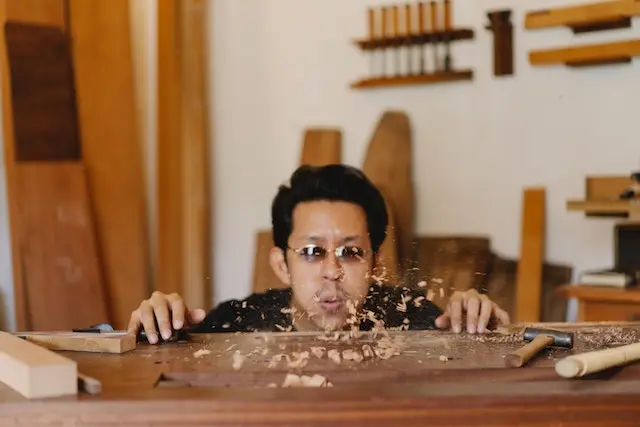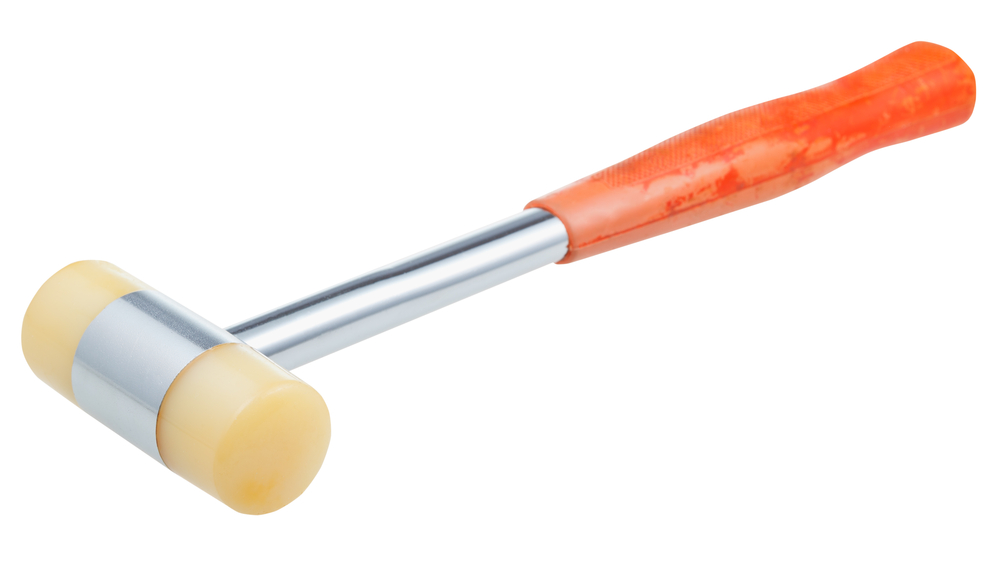Plan to have a dead blow hammer or a rubber mallet: Which has the right striking power? Both tools allow you to hit objects with force without damaging them as a traditional hammer would, but that does not mean they are the same. They have many things in common, but some differences make them special. Each of them has its advantages and disadvantages. Let us look at the uses, advantages and disadvantages of the hammers.
Dead Blow Hammer
Definition and explanation of a dead blow hammer
A hammer is a hammer-like tool used to absorb shock when the hammer is struck. It prevents damage to soft surfaces, reduces rebound, and improves the hammer’s striking power. It is made of hard materials without an external coating of plastic or urethane to avoid scratches in the wood.
Types of dead blow hammers
- Standard Dead Blow Hammer
- Soft Face Dead Blow Hammer
- Mini Dead Blow Hammer
Advantages of using a dead blow hammer
- It prevents damage to soft surfaces
- It reduces the amount of rebound
- It improves the striking force of the hammer
Common uses for a dead blow hammer
- Automotive applications
- Woodworking
- Carpentry
- Metalworking

Types of Dead Blow Hammers
Standard Dead Blow Hammer
It features a contoured grip, balanced swing, and dead blow striking force. Hot-cast urethane is durable from our proprietary formula.
Soft Face Dead Blow Hammer
This hammer is used for non-marring, such as cabinetry and other fine woodworking jobs. Soft face hammers feature replaceable tips made of nylon, rubber, plastic, and other soft compounds.
Mini Dead Blow Hammer
The Mini Slam Dead Blow Hammer is for levelling and aligning pavers. Its strong nylon face will not damage masonry surfaces.
Advantages of using a Dead Blow Hammer
- Reduces damage to the surface being struck
- Prevents bouncing back of the hammer
- Increased accuracy in striking
- Reduces user fatigue
Common Uses for a Dead Blow Hammer
Automotive work
In woodworking, they knock joints together or apart without denting the wood pieces being worked on.
Metalworking
A dead-blow hammer seats the workpiece against parallels in a machine vice.
Woodworking
It knocks joints together or apart without denting the wood pieces being worked on in woodworking.
Construction
Dead Blow mallets work in installing commercial and residential slab marble and granite applications.
Rubber Mallet
Definition and explanation of a rubber mallet
A rubber mallet is a lightweight hammer-like tool with a head of moulded rubber or hard plastic and a wooden handle. Rubber mallets, also called soft mallets, are used for a softer blow than what a wooden mallet might make. The heads of rubber mallets may shred over time if you use them for pounding sharp items like carpet tack strips (Thespruce.com). Replace your mallet if the head has become shredded or pitted.
Types of rubber mallets
- Standard Rubber Mallet
- Hard Rubber Mallet
- Soft Rubber Mallet
Advantages of using a rubber mallet
- There is no risk of leaving traces of rubber on the surfaces of ceramic tiles.
- Lightweight
- Affordable
Common uses for a rubber mallet
- Shift panels of drywall into place.
- Tapping bricks or pavers into the sand.
- Taps ceramic or stone tiles into place.
Types of Rubber Mallets
Standard Rubber Mallet
That is an all-purpose mallet used for automotive and industrial purposes.
Hard Rubber Mallet
It is for striking an object that a standard hammer would leave a mark in.
Soft Rubber Mallet
A soft rubber mallet is a hammer designed to offer driving force without damaging surfaces.

Advantages of using a Rubber Mallet
- Prevents damage to the surface being struck
- It does not cause dents or scratches
- Easy to use for delicate work
- Versatile for use with a variety of materials
Common Uses for a Rubber Mallet
- Woodworking
- Metalworking
- Upholstery
- Tile installation
Comparison of Dead Blow Hammer and Rubber Mallet
Strengths and weaknesses of each tool
Rubber mallets bounce, and dead blow hammers do not.
Differences in design and construction
Dead blow hammers contain heavier, stronger heads, and when they hit something, they will not rebound or bounce back, whereas rubber mallets will bounce back.
Materials each tool can be used on
The rubber mallet is soft and non-slip Tpr material with jacketed fiberglass, whereas the dead blow hammer is soft and non-slip Pvc material.
The impact force of each tool
Dead blow hammers contain heavier, stronger heads, and when they hit something. They will not rebound or bounce back, whereas a rubber mallet will bounce back, making it awkward. A dead blow hammer hits with greater force and won’t bounce back.
Factors to Consider When Choosing Between a Dead Blow Hammer and Rubber Mallet
Nature of the project
The nature of the project determines its use.
Materials being worked on
Since these work on different materials like soft or hard, each requires a type of wood.
Personal preference
Since you know both pros and cons of both tools, take what you prefer.
Budget
Buy a hammer that you can afford to upgrade as you go.
Conclusion
In conclusion, Dead Blow Hammer or Rubber Mallet are different mallets with designs, uses, and forces. We hope that this guide has conveyed the difference between dead blow hammers and rubber mallets, so if the need arises, you will not struggle to pick the best since you will have all the information you need to choose the right one.
FAQs
What is a dead blow hammer?
A dead blow hammer is a special type of hammer that contains a cavity filled with sand or shot to absorb shock and reduce recoil. This design helps minimize damage to the striking surface and improves hit accuracy. Dead-blow hammers are commonly used in the automotive, construction and woodworking industries to reduce vibration and provide more controlled blows.
What is a rubber mallet?
A rubber mallet is a lightweight, hammer-like tool with a molded rubber or hard plastic head and a wooden or fiberglass handle.
How do I choose between a dead blow hammer and a rubber mallet?
Consider your budget, the type of project you are working on, and the materials you will be working with.
Can a dead blow hammer be used on delicate materials like wood?
No, a dead blow hammer is not recommended for delicate materials like wood, as it can leave damage or marks on the surface. It is better to use a softer hammer or a hammer specially designed for woodworking.
Can a rubber mallet be used for heavy-duty projects?
No, rubber mallets are not for heavy work. They are intended for light work, and using them for heavy work can damage the hammer or injure the user.
Do I need to wear protective gear when using a dead blow hammer or rubber mallet?
Yes, wearing appropriate personal protective equipment, such as safety glasses, is recommended to protect your eyes from flying debris or particles when using a hammer or rubber mallet. You should also wear gloves to protect your hands from accidental blows or bruises.
What are some safety tips for using a dead blow hammer or rubber mallet?
When using a dead blow hammer or rubber mallet, following safety guidelines to prevent injury is important. Here are some safety tips:
- Wear safety goggles or glasses to protect your eyes from flying debris.
- Do not use excessive force when striking an object, which could cause the hammer or mallet to rebound and hit you.
- Always have proper storage for your tools when not in use to prevent accidental injury.
- Use the hammer or mallet only for its intended purpose, and do not use it on surfaces the impact may damage.
How do I properly care for and maintain my dead blow hammer or rubber mallet?
To properly care for and maintain your hammer or rubber mallet, it is important that you use it on softer surfaces to avoid damaging the striking surfaces. Check the hammer or rubber mallet regularly for signs of wear, cracks or damage to the handles and replace if necessary. It is also important to keep the striking surfaces clean and free of debris to avoid damaging the surface being worked on. Store your hammer or mallet in a dry and protected location to prevent rust and other damage.
Can I use a dead blow hammer or rubber mallet for automotive projects?
Dead-blow and rubber hammers can be used for various automotive projects, such as working on the chassis, loosening stuck parts, and sometimes installing and removing hubcaps.
Are dead blow hammers and rubber mallets expensive?
No, they are affordable. Dead blow hammers and rubber mallets are considered affordable compared to other types of hammers and mallets.
- Grain and Sheen: Teak Oil versus Danish Oil Uncovered - January 10, 2024
- The Cherry on Top: Crafting the Perfect Cutting Board - January 9, 2024
- Polyurethane Water-Based vs Oil-Based: Choosing the Right Finish - January 8, 2024